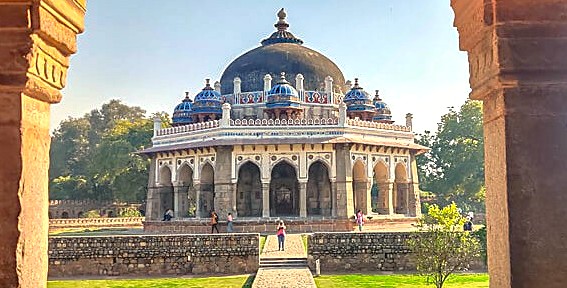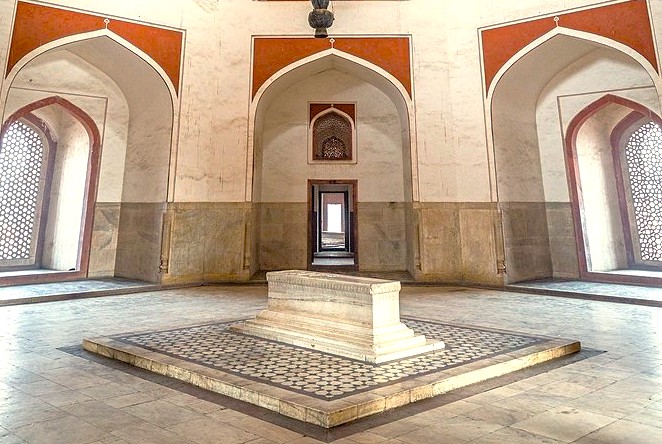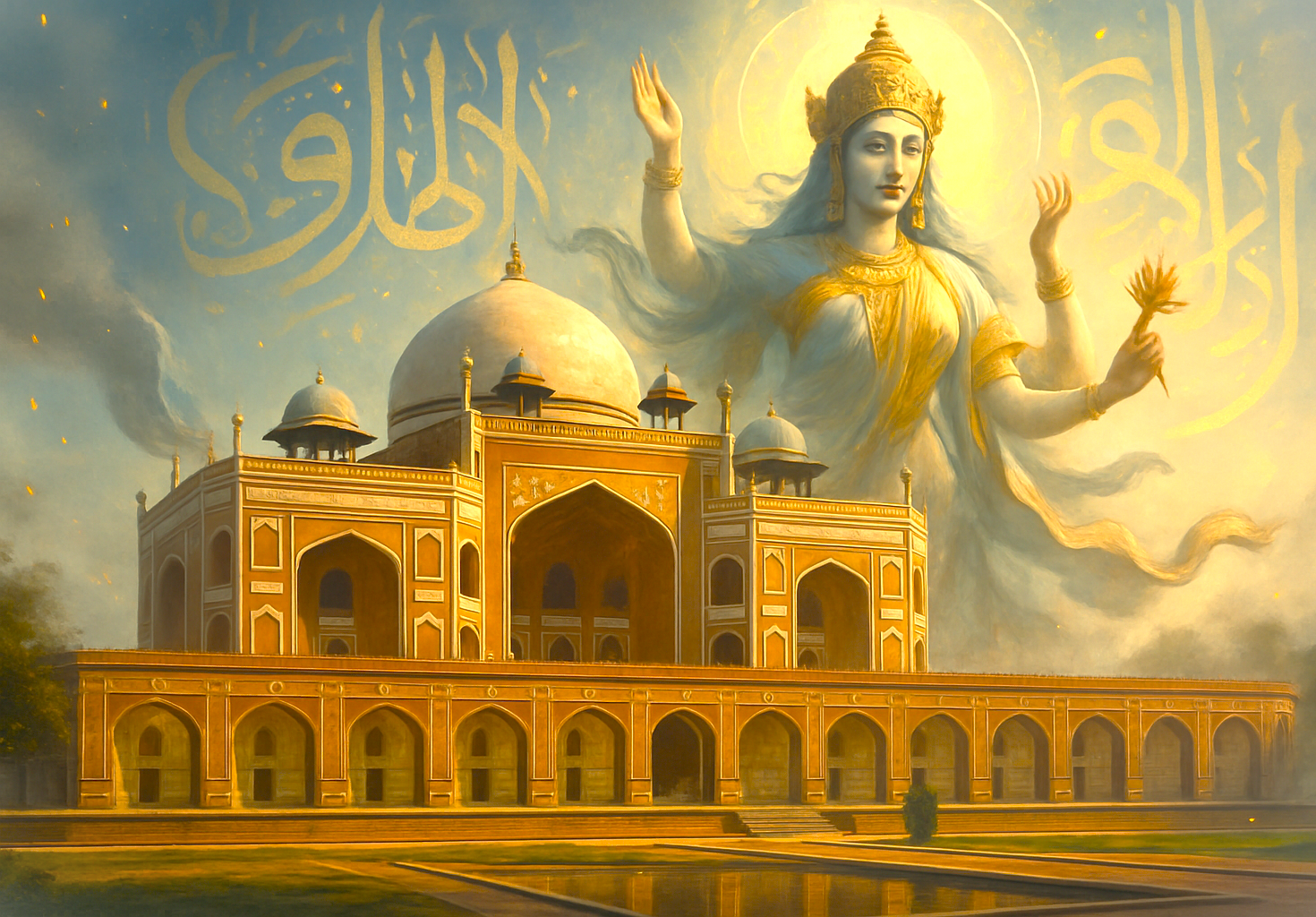Rajasthani Legends
Humayans Tomb Delhi NCT India
Mother Masala tours
The First Mughal Mausoleum
Humayans Tomb Delhi NCT India. Constructed between 1569 and 1572 under the orders of Humayun's widow, Empress Hamida Banu Begum, this mausoleum is regarded as the first garden-tomb on the Indian subcontinent. The design laid the foundation for subsequent Mughal architecture, including the famous Taj Mahal, completed later in the century. The tomb is a Unesco World Heritage Site, celebrated for its stunning Persian-style gardens and its grand structure, which combines Indo-Islamic architectural elements. With a height of 47 meters, the tomb features a large dome and intricate calligraphy and floral motifs adorning its walls. The entire complex is set within a 30-acre garden, offering a peaceful respite from the city.

Humayans Tomb Delhi NCT India: Sacred Spaces
Within the vast grounds of the Tomb, a variety of timeless artifacts can be found that depict the artistic and spiritual heritage of the Mughal Empire. The tomb complex is not only an architectural feat but also a site rich in historical objects, including ornate marble screens, carefully curated gardens, and intricate tile work. The main tomb features exquisite inlay work, with semi-precious stones that form detailed floral designs, a hallmark of Mughal artistry. As we walk the gardens, we find other smaller tombs and monuments, such as the tomb of I'timād-ud-Daulah, revealing a blend of red sandstone and white marble, a precursor to the later techniques seen in the Taj Mahal.
Impeccable Craftsmanship

The craftsmanship of this Tomb shows the great skill of Mughal artisans. Built mostly from red sandstone, it has white marble parts. This mix creates a striking visual look. The tomb's designs are very detailed, made by skilled workers who decorated the walls and ceilings with fine patterns. These patterns added to its lasting beauty and historical feel. A key part of the tomb is its jali work, which are carved screens. These screens let air flow through and make interesting shadows. This blend of materials and art creates a lasting masterpiece.
The Pulse of the Local Community
Humayans Tomb Delhi NCT India. The people residing near the Tomb contribute a unique charm to the area, offering hospitality and warmth that reflects the rich culture of Delhi. Their friendliness is palpable as they engage with anyone exploring the historic site and its surroundings. The local community includes families who have lived in the area for generations, maintaining a strong connection to the landmark.
Capturing the Magic: A Photographic Haven

This tomb offers many chances for striking photos. Its balanced shape and green gardens provide calm backgrounds. Detailed carvings and peaceful pools present lovely scenes for our cameras. Light and shadows at sunrise or sunset make photos special. We observe many locals and families enjoying the park, walking paths or resting on benches. This garden tomb possesses a clear, understated beauty. Grand arches and delicate patterns offer quiet inspiration throughout the grounds. History and nature mix well, providing a simple, pleasant experience.
A Culinary Journey: Savor the Flavour
Exploring the vicinity, we discover delicious local specialties that enhance the overall experience. One dish you must try is biryani, a fragrant rice dish that has gained immense popularity in Delhi. This dish typically features marinated meat, long-grain basmati rice, and a blend of spices including saffron, cardamom, and cloves. The preparation involves layering the ingredients and slow-cooking them in a sealed pot, allowing the flavors to meld beautifully. The result is a sumptuous dish celebrated for its rich flavors and aromatic qualities. Local eateries often serve biryani with raita, a cooling yogurt-based side dish.
The Connection with the Gods

Humayun's legacy is intertwined with various historical narratives, including influences from religious beliefs. Though the tomb does not represent a specific deity, it reveals the cultural blend of Hinduism and Islam that marked the Mughal Empire. This fusion of traditions is evident in its architectural details and peaceful coexistence it represents. One notable character connected to this site is the Sufi saint Nizamuddin Auliya - emphasize's love, tolerance, and harmony among different faiths. His message resonated widely. This integration of beliefs creates a mix of spiritual influences.
Festivals of Devotion: Honouring the Sacred and the Divine
Often a focal point for various cultural and religious celebrations that resonate within the local community. One significant festival is the Urs of Nizamuddin Auliya, which takes place annually in February and marks the death anniversary of the famous Sufi saint. This event attracts countless devotees, bringing together people from diverse backgrounds in a spirit of unity and reverence. During the Urs, spiritual music, prayers, and gatherings create an atmosphere of devotion, honoring the legacy of Nizamuddin Auliya.
Resilience and Renewal: Overcoming Adversity’s Challenges

The history here includes periods of significant turmoil and remarkable resilience. Following Humayun's death in 1556, the nascent Mughal Empire faced many challenges. These included intense internal conflicts and power struggles that threatened its very foundation. Despite difficulties, his widow's unwavering determination to construct this mausoleum profoundly reflected the spirit of perseverance that characterized the entire era. This resolve helped solidify the empire's future. The tomb's design introduced new styles and techniques. These innovations were later refined and used in other great Mughal buildings.
Serendipitous Meetings: Beyond the Main Path
Humayans Tomb Delhi NCT India. Walking around the area surrounding the tomb enriches our experience through unexpected discoveries. Hidden cafés and artisan shops dot the streets, allowing us to stumble upon local crafts, handmade textiles, and jewelry that reflect the area's rich heritage. These encounters offer insights into the daily lives of the community. You may come across small workshops where craftspeople create intricate designs using traditional techniques, giving us a glimpse into the time-honored artistry of the region.
Ancient Technologies: Sound, Sacred Geometry & Astrological Influences

The construction of the Tomb exemplifies ancient knowledge in design and engineering. Its layout incorporates profound principles of Vastu Shastra sacred geometry, like the golden ratio, creating harmonic proportions that deeply influence the tomb's serene and tranquil atmosphere. High ceilings and meticulously designed chambers ingeniously utilize natural acoustics, enhancing spiritual sounds with Solfeggio properties during ancient ceremonies. The materials, primarily rich red sandstone and white marble, carry deep symbolic meanings, reflecting purity and earthly connection.
Urban Legends: Strange Sightings, Myths and Mysteries
The rich history has inspired several local legends and myths that contribute to its allure. One popular tale recounts the spirit of Humayun, who is said to wander the grounds under the light of the moon. Some residents claim to have caught fleeting glimpses of a shadowy figure near the tomb, often interpreted as the emperor himself watching over his final resting place. Another myth speaks of the gardens that surround the tomb; locals believe that a particular flower blooms only during moments of shared joy.
India, Discover Why The Cows Always Have Right of Way

Join Us as we walk through the serene gardens and admire the stunning craftsmanship, we’ll uncover the stories that shaped the tomb and the very fabric of India's cultural heritage. Our journey will take us through moments of reflection and discovery, allowing us to engage with the rich narratives surrounds. This architectural marvel beautifully reveals Mughal ingenuity and a profound love. Every intricate detail, from the grand domes to the delicate jalis, tells a narrative of devotion and imperial power. We observe how this Unesco site seamlessly blends Persian and Indian architectural traditions.
Symphony of Generosity: Offerings from Wanderers to Residents
Humayans Tomb Delhi NCT India. The interaction between the local residents and those exploring Humayun's Tomb has created a beneficial exchange that enriches both parties. As travelers learn about the history and culture, the locals share their stories, culinary delights, and handcrafted items, creating an integrated experience. The support for local artisans and vendors provides economic benefits to the community while allowing us to take home unique mementos that reflect the cultural tapestry of the area.